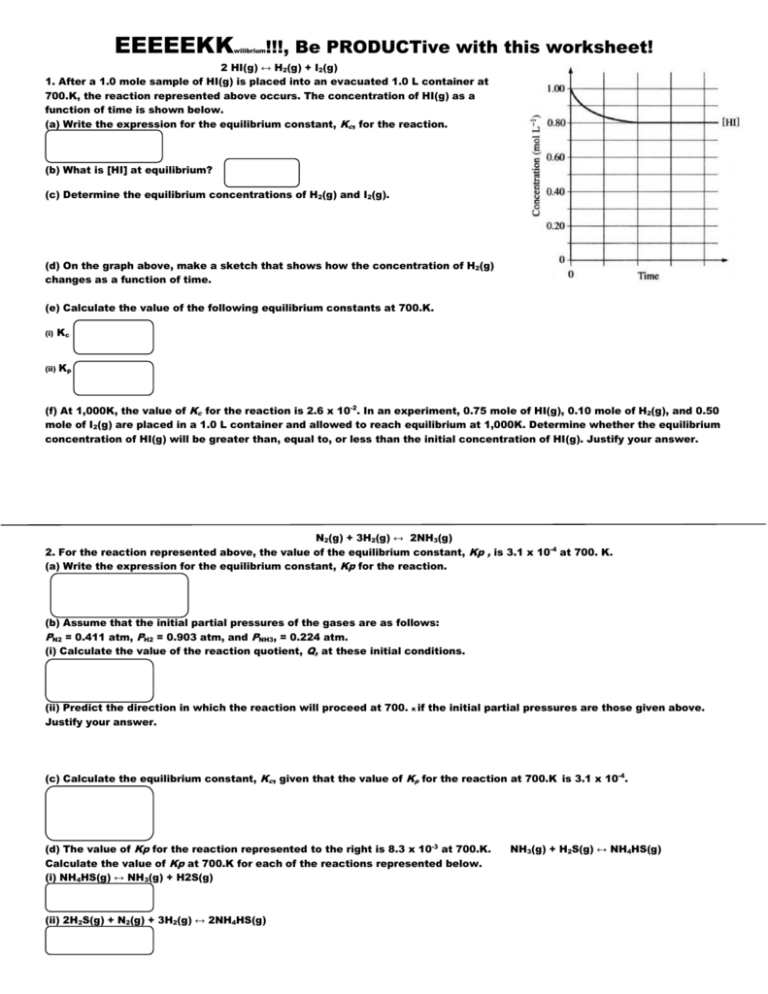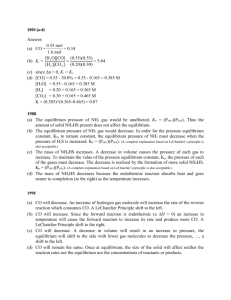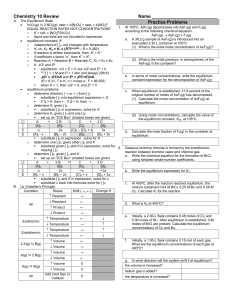EEEEEKKwilibrium!!!, Be PRODUCTive with this worksheet! 2 HI(g
advertisement

EEEEEKK !!!, Be PRODUCTive with this worksheet! wilibrium 2 HI(g) ↔ H2(g) + I2(g) 1. After a 1.0 mole sample of HI(g) is placed into an evacuated 1.0 L container at 700.K, the reaction represented above occurs. The concentration of HI(g) as a function of time is shown below. (a) Write the expression for the equilibrium constant, Kc, for the reaction. (b) What is [HI] at equilibrium? (c) Determine the equilibrium concentrations of H2(g) and I2(g). (d) On the graph above, make a sketch that shows how the concentration of H2(g) changes as a function of time. (e) Calculate the value of the following equilibrium constants at 700.K. (i) Kc (ii) Kp (f) At 1,000K, the value of Kc for the reaction is 2.6 x 10-2. In an experiment, 0.75 mole of HI(g), 0.10 mole of H2(g), and 0.50 mole of I2(g) are placed in a 1.0 L container and allowed to reach equilibrium at 1,000K. Determine whether the equilibrium concentration of HI(g) will be greater than, equal to, or less than the initial concentration of HI(g). Justify your answer. N2(g) + 3H2(g) ↔ 2NH3(g) 2. For the reaction represented above, the value of the equilibrium constant, Kp , is 3.1 x 10-4 at 700. K. (a) Write the expression for the equilibrium constant, Kp for the reaction. (b) Assume that the initial partial pressures of the gases are as follows: PN2 = 0.411 atm, PH2 = 0.903 atm, and PNH3, = 0.224 atm. (i) Calculate the value of the reaction quotient, Q, at these initial conditions. (ii) Predict the direction in which the reaction will proceed at 700. K if the initial partial pressures are those given above. Justify your answer. (c) Calculate the equilibrium constant, Kc, given that the value of Kp for the reaction at 700.K is 3.1 x 10-4. (d) The value of Kp for the reaction represented to the right is 8.3 x 10-3 at 700.K. Calculate the value of Kp at 700.K for each of the reactions represented below. (i) NH4HS(g) ↔ NH3(g) + H2S(g) (ii) 2H2S(g) + N2(g) + 3H2(g) ↔ 2NH4HS(g) NH3(g) + H2S(g) ↔ NH4HS(g) C(s) + CO2(g) ↔ 2 CO(g) 3. Solid carbon and carbon dioxide gas at 1,160K were placed in a rigid 2.00 L container, and the reaction represented above occurred. As the reaction proceeded, the total pressure in the container was monitored. When equilibrium was reached, there was still some C(s) remaining in the container. Results are recorded in the table. (a) Write the expression for the equilibrium constant, Kp , for the reaction. (b) Calculate the number of moles of CO2(g) initially placed in the container. (Assume that the volume of the solid carbon is negligible.) (c) For the reaction mixture at equilibrium at 1,160K, the partial pressure of the CO2(g) is 1.63 atm. Calculate (i) the partial pressure of CO(g) , and (ii) the value of the equilibrium constant, Kp . (d) If a suitable solid catalyst were placed in the reaction vessel, would the final total pressure of the gases at equilibrium be greater than, less than, or equal to the final total pressure of the gases at equilibrium without the catalyst? Justify your answer. (Assume that the volume of the solid catalyst is negligible.) In another experiment involving the same reaction, a rigid 2.00 L container initially contains 10.0 g of C(s), plus CO(g) and CO2(g), each at a partial pressure of 2.00 atm at 1,160K. (e) Predict whether the partial pressure of CO2(g) will increase, decrease, or remain the same as this system approaches equilibrium. Justify your prediction with a calculation. 4. Answer the following questions regarding the decomposition of arsenic pentafluoride, AsF5(g) . (a) A 55.8 g sample of AsF5(g) is introduced into an evacuated 10.5 L container at 105°C. (i) What is the initial molar concentration of AsF5(g) in the container? (ii) What is the initial pressure, in atmospheres, of the AsF5(g) in the container? At 105°C, AsF5(g) decomposes into AsF3(g) and F2(g) according to the following chemical equation. AsF5(g) ↔ AsF3(g) + F2(g) (b) In terms of molar concentrations, write the equilibrium-constant expression for the decomposition of AsF5(g). (c) When equilibrium is established, 27.7 percent of the original number of moles of AsF 5(g) has decomposed. (i) Calculate the molar concentration of AsF5(g) at equilibrium. (ii) Using molar concentrations, calculate the value of the equilibrium constant, Keq , at 105°C. (d) Calculate the mole fraction of F2(g) in the container at equilibrium.







